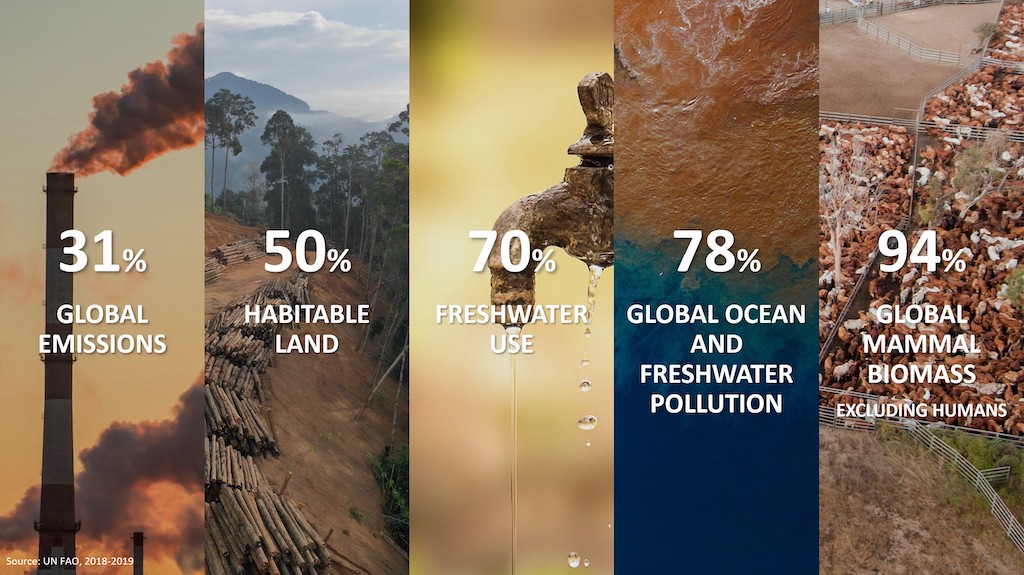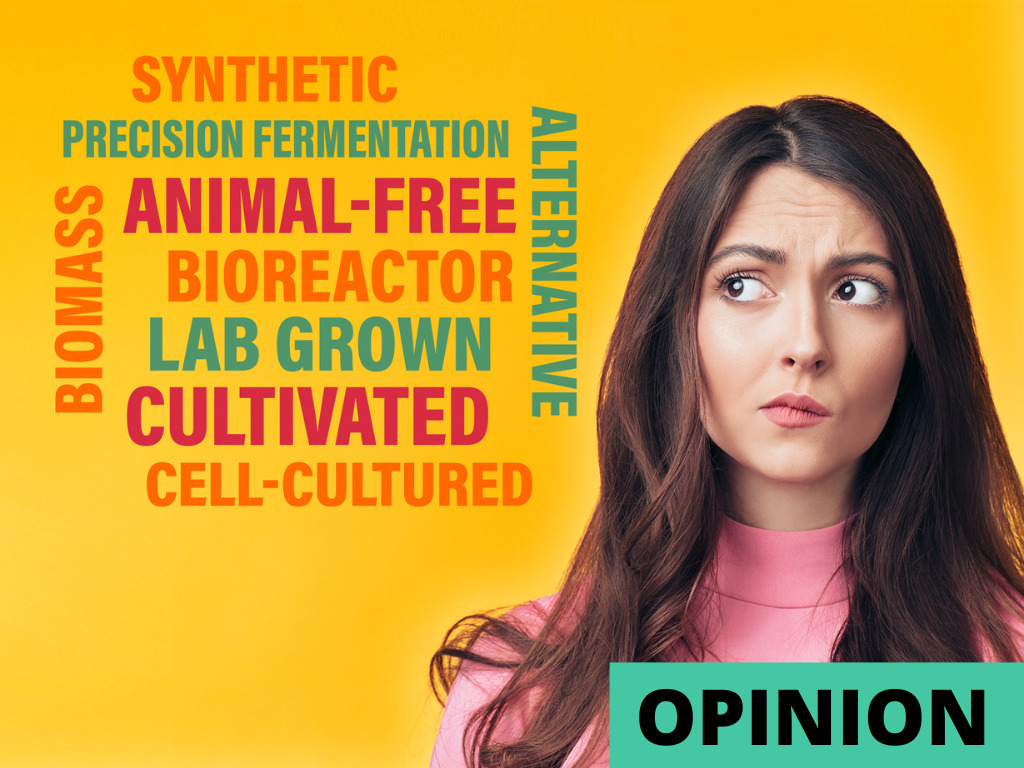8 Mins Read
Notes From the Frontlines of the Sustainable Food Movement – an opinion column by Irina Gerry
Food and climate are intrinsically linked: the way we produce food today is not sustainable. This much we know. Startups across the globe are using innovation to create healthy, nutritious, and lower-emission foods. What will it take for consumers to embrace them?
Our food and climate worlds are colliding. If you spend any time around the sustainable food movement, you know that the way we feed ourselves is not sustainable. Already occupying half of all habitable land, agricultural expansion is responsible for massive deforestation and biodiversity loss. Agriculture consumes 70% of all freshwater on Earth and is the leading driver of fresh and ocean water pollution. Our industrious ways of feeding 8 billion humans result in untold damage to the ecosystems, in addition to driving nearly a third of global greenhouse gas emissions.

Any way you look at it, animal agriculture shows up as the biggest contributor to our food system’s most intractable problems. From land use and deforestation, ecosystem degradation, and emissions, to pollution associated with pesticide use and manure runoff, raising livestock for food emerges as the most destructive food production technology on the planet.
We know we can’t go on with the status quo. We know we can’t continue to supply the ever-increasing appetite for animal foods of the growing global population and the rising middle class. Change is mandatory.
Consumers would like to live more sustainably as well. Nielsen IQ data reveals that 78% of consumers say a sustainable lifestyle is important to them and 30% are more likely to purchase products with sustainable credentials. However,a majority of them focus on packaging, recycling and food waste rather than animal product consumption.
If it were simply a matter of education and illuminating the connection between animal foods and climate, we would have a much easier time bringing about this change. However, we all know that food is a very emotional category. Food is about enjoyment and pleasure. Food is about nourishing ourselves and our families. Food defines our tribes, shapes our culture, and preserves traditions. Unfortunately, convincing people to go vegan for the planet, the animals, or even their health, has gained little traction with the general population.
The good news is, we have several innovative solutions, which do not require a wholesale change to our eating habits: products that replace animal-based foods, made without animals. Plant-based milk has carved out a significant and growing share of the dairy market. Plant-based ice cream, meat, yogurt, eggs, and cheese are still tiny but must grow for the sake of our collective future.
Exciting new technologies are on the horizon as well. Cultivated meat allows us to grow chicken breasts and steaks in bioreactors instead of slaughtering animals. Biomass fermentation can be used to cultivate microorganisms, like mycelium, to create nutritious sources of protein, fiber and other micronutrients. Precision fermentation allows us to use microorganisms, instead of animals, to produce key nutrients such as milk proteins, fats, and flavors. The premise of these new technologies is to replicate, not mimic, animal-based foods, at a fraction of the environmental footprint.
Sounds amazing! If we build it, they will come. Right?
While technological and logistical feats required to scale these new food production technologies deserve their own consideration, I would like to focus on the end consumer for this conversation. Because even if these solutions were available today, at scale and at price parity, we would still need to grapple with consumer acceptance. What will it take for regular consumers to embrace these new foods and bring them into their homes and everyday lives?
Tailwinds
The reality of climate change is hitting home. Visible and experienced firsthand in every corner of the world, climate change is driving our desire to act. Gen Z-ers and parents of young kids are particularly concerned about the future. Young people everywhere demand action. And yet, most of us feel powerless to drive real change, be it through corporate power structures, politics or individual action. Food presents an actionable outlet. Every single one of us can be a climate hero for breakfast, simply by choosing to shift out diets toward plant-based options. By connecting the dots on food and climate, we can empower billions of people to drive change through their daily consumption, as well as social and market signaling that comes with our food choices.
The reality of climate and the simple mathematical impossibility of scaling animal agriculture against planetary boundaries mandate change. Whether we like it or not, our food system will change. Some of this change will be brought about by the changing climate: already droughts in the Western US are pressuring water-intensive dairy and almond production, heat waves are reducing milk yields and killing livestock, reduced crop yields are driving up prices of key inputs, reshaping economic fundamentals. Some of this change will be brought about by a greater societal awakening to the impact of our food choices on climate, animals and social injustice, and the search for more sustainable alternatives. Alternatives for traditional animal products will be a part of our food future.
Headwinds
There are, however, several important headwinds facing the sustainable food movement, which may slow, if not derail, consumer adoption.
Nature vs. Technology
First, we have to understand that food lives in a different mental plane from technology. While we readily embrace technology in gadgets, medicines and communications, we prefer our food to remain “natural”. For many, this means traditional, recognizable foods, consistent with our cultural heritage. The narratives of hard-working farmers, stewarding the land, taking care of the crops and animals, and delivering wholesome products run deep. Despite the prolific infiltration of industrial technology into food (pastured chicken of the past looks nothing like the modern broiler), we perceive traditional foods to be natural, wholesome and healthy.
Many consumers recoil at the idea of bringing technology into food. While they may embrace the idea of technological solutions necessary for the greater good, the majority still want the food they eat to come from “natural” sources. The organic and regenerative movements embody this desire to go “back to basics” in agriculture. This nature vs technology tension presents a real concern we must grapple with.
A possible way to address it is to position innovative animal-free products as options or pieces of the overall diverse food puzzle, rather than an either-or ideological divide. No one eats kale salad all day, just as no one survives solely on hot dogs. The majority of consumers mix and match options depending on their needs and the context of the moment. An Impossible burger shares the plate with steamed broccoli, and oat milk shares the fridge with cow’s cheese. Our job is to provide the right products, at the right price, in the right place, along with the right communication strategy to overcome this barrier and tip the balance in favor of sustainable alternatives.
Lack of Trust and Familiarity
Let’s be honest, it is hard to explain and understand how we turn plants into burgers or grow chicken breasts in a bioreactor. As unpalatable as animal slaughter is, most of us understand the process involved. Since humans have been eating animals for millennia, there is an inherent trust in the process and familiarity with the product.
Because the new food production technologies are unfamiliar, we are intuitively skeptical. It goes back to the early civilization principles of trusting the foods your grandparents ate. Building trust and familiarity requires a greater degree of transparency around the process, positive experience with products and multiple exposures over time.
As evolved as we are, humans are still fundamentally tribal. Watching members of your tribe consume certain foods gives you confidence in the safety of these foods. Receiving endorsements from the “leaders of the tribe”, be it social media influencers or trusted third parties like doctors and regulators builds trust. Third-party endorsements, verifications and certifications will play a key role in building trust in the new food products.
Concerns Around Unintended Consequences
Layering on top of the preferences and trust for traditional foods, lie higher-order concerns around the potential unintended consequences of innovation. Human civilization has progressed because of innovation. Innovation in agriculture, transportation and medicine brought about fundamental leaps in humanity’s progress, assuring longer, safer and healthier lives. However, just about every innovation had its unintended consequences, from leaded water pipes affecting cognition to highly processed foods damaging our health, to climate change driven by our fossil-based energy infrastructure. In that context, concerns around potential unintended harms associated with innovative food technologies are not without their merit.
While the sustainable food movement is full of mission-driven entrepreneurs, for whom the desire to build a sustainable food system runs deep, we must be mindful of the broader potential environmental, health and societal implications of food systems transformation. The climate case for innovative food technologies must be strengthened with data and measurement, as well as an honest assessment of how these products interplay with natural ecosystems.
We must answer consumer desires for healthy, tasty, and sustainable foods. Health and wellness are still the most important driver of food purchases. Very few consumers would be willing to subjugate their health for the greater good of the planet, society or animals. This means we must deliver products that are not only tasty and good for the planet, but also nutritionally sound.
Agriculture is intertwined in the very fabric of society. People who grow, process and prepare our food must be included in food system transformation. This cuts across developed and developing countries, where transformation of food systems spells disruption to the lives and livelihoods of billions of people. As heavy of a burden as it is, new food companies must think of themselves as actors in the context of the broader food and societal transformation. Ethical considerations from social justice to the treatment of animals and just transition for farmers must be addressed if we are to make progress together.
Drafting off tailwinds and navigating the headwinds successfully will determine how quickly these new food technologies can become a part of the sustainable food future. In my next post, I’ll share five strategies for navigating these tricky waters. Stay tuned.




